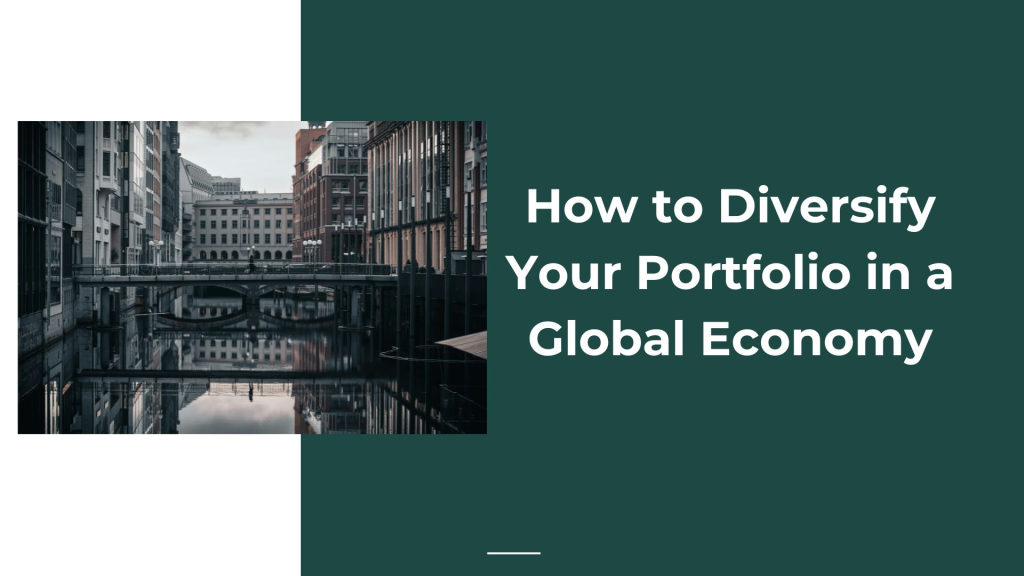How to Diversify Your Portfolio in a Global Economy
In today’s interconnected world, investing globally can offer tremendous opportunities for growth and financial security. But with those opportunities come risks, which is why diversification is key to protecting your investments. If you’re new to investing or looking for ways to strengthen your portfolio, this guide will explain why and how to diversify in a global economy. Don’t worry—it’s easier than it sounds!

What Does It Mean to Diversify Your Portfolio?
At its core, diversification means not putting all your eggs in one basket. Instead of investing all your money in a single stock or type of asset, you spread your investments across different types of assets, industries, and regions. This helps reduce the risk of losing your money if one area of your investments underperforms.
In a global economy, diversification means expanding your portfolio beyond just domestic (local) investments to include international opportunities. This way, you can tap into growth in different parts of the world and reduce the risk that your investments will be negatively impacted by events in a single country or market.
Why Is Diversification Important in a Global Economy?
With the global economy becoming more interconnected, events in one country can affect markets worldwide. By diversifying your portfolio internationally, you can spread out risk and take advantage of growth opportunities in different regions.
Here’s why diversification is important:
- Reduces Risk: When you diversify, poor performance in one investment is often offset by better performance in others. For example, if the stock market in your country goes down, investments in other countries or regions may still perform well.
- Takes Advantage of Global Growth: Different countries experience economic growth at different times. By investing in a variety of regions, you can benefit from growth wherever it happens—whether that’s in emerging markets like Asia or in established markets like Europe or North America.
- Protects Against Local Crises: Political, economic, or social crises in a single country can affect that country’s market. By diversifying into international assets, you can reduce the risk that these crises will have a major impact on your overall portfolio.
Steps to Diversify Your Portfolio in a Global Economy
Ready to start diversifying? Here’s a simple guide to help you spread your investments across different types of assets and regions.
1. Invest in Different Asset Classes
One of the first steps in diversification is spreading your money across different asset classes. Each type of asset behaves differently, so having a mix can protect you from the ups and downs of any one type.
- Stocks: Buying shares in companies can offer high returns, but it also comes with higher risk. Make sure to include both domestic and international stocks in your portfolio.
- Bonds: Bonds are generally considered safer than stocks. They provide steady income and are less volatile. Consider investing in government and corporate bonds from different countries.
- Real Estate: Real estate investments, either directly or through real estate investment trusts (REITs), provide steady returns through rental income and property value appreciation.
- Commodities: Commodities like gold, oil, and agricultural products can be a good hedge against inflation and provide diversification in times of market instability.
By mixing these asset types, you’ll have a balanced portfolio that can perform well in different economic environments.
2. Invest in Different Sectors and Industries
Another important aspect of diversification is spreading your investments across various sectors of the economy. Different industries react differently to economic changes, so having a diverse range of sectors helps reduce risk.
- Technology: Tech companies can offer high growth, but they can also be volatile.
- Healthcare: Healthcare tends to be more stable, especially in times of economic uncertainty.
- Energy: Energy investments like oil and renewable energy are influenced by global demand and political factors.
- Consumer Goods: Companies that produce everyday items like food and household products tend to be more stable.
By investing in a mix of industries, you won’t be overly exposed to downturns in any single sector.
3. Explore International Markets
To fully diversify your portfolio in a global economy, it’s important to include international investments. Different regions and countries offer varying opportunities for growth.
- Developed Markets: These include countries like the U.S., Canada, Japan, and Germany. Their economies tend to be more stable but may offer slower growth compared to emerging markets.
- Emerging Markets: These are countries with rapidly growing economies, such as China, India, and Brazil. While these markets can offer high returns, they also come with higher risks due to political and economic instability.
- Frontier Markets: These are smaller or less developed markets, such as Vietnam or Kenya. They can offer the potential for significant growth, but they also come with high volatility and risk.
You can easily invest in international markets through mutual funds or exchange-traded funds (ETFs) that focus on global or regional investments. These funds give you exposure to a variety of international companies without having to pick individual stocks.
4. Consider Currency Risk
When you invest internationally, you also expose yourself to currency risk. Exchange rates between your home currency and foreign currencies can fluctuate, affecting the value of your investments. While this can be a risk, it can also provide an opportunity for gains if foreign currencies strengthen against your home currency.
To manage this risk, consider:
- Hedging: Some international funds offer “hedged” options that protect against currency fluctuations.
- Investing in a Mix of Currencies: By diversifying across countries with different currencies, you can reduce the impact of any single currency’s movement on your portfolio.
5. Stay Informed and Rebalance Regularly
Diversifying your portfolio is not a one-time task. The global economy is constantly changing, so it’s important to stay informed about global events, market trends, and the performance of your investments.
- Rebalancing: Over time, the value of different investments in your portfolio will change. Regularly rebalanceyour portfolio to ensure that it stays aligned with your goals and risk tolerance. For example, if one of your international stocks has grown significantly, it might now make up a larger portion of your portfolio than intended. Rebalancing would involve selling some of that stock and reinvesting in other areas to maintain your desired level of diversification.
Tools for Diversifying Globally
You don’t have to be a financial expert to diversify your portfolio. There are several tools available that make global investing easy:
- Mutual Funds & ETFs: These funds allow you to invest in a basket of stocks, bonds, or other assets from around the world, reducing the risk of relying on a single investment.
- Robo-Advisors: Robo-advisors like Betterment or Wealthfront offer automated portfolio management services that help you diversify globally based on your risk tolerance and goals.
- Online Brokerage Accounts: Platforms like Fidelity, Schwab, or E*TRADE offer access to international markets, allowing you to buy stocks, bonds, and funds from various countries.
Conclusion
Diversifying your portfolio in a global economy can help you take advantage of opportunities in different regions while reducing the risk of market downturns. By investing across asset classes, industries, and regions, you can protect yourself from volatility and position your portfolio for long-term growth.
Remember, no investment strategy is without risk, but diversification is one of the most effective ways to manage it. As you start building or rebalancing your portfolio, take your time to research, stay informed about global trends, and consider consulting with a financial advisor to ensure your strategy aligns with your financial goals.
Happy investing!


